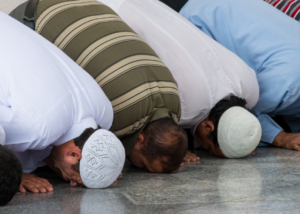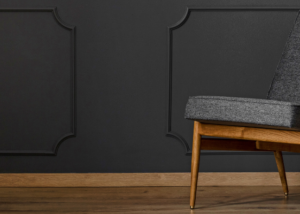Quran
Hadith
Islamic Text
بِسْمِ اللَّهِ الرَّحْمَنِ الرَّحِيمِ
In the Name of Allah Most Merciful Most Kind
Short Answer
Yes, it is true that a sitting Imam can lead a sitting follower. However, such an Imam cannot lead a standing follower. This is in the case when the Imam is sitting on a chair and imitating Sajdah. However, this is opposed to an Imam sitting on the floor and performing a standard Sajdah as he can lead a standing person.
Follow the Imam
إِنَّمَا جُعِلَ الإِمَامُ لِيُؤْتَمَّ بِهِ، فَإِذَا رَكَعَ فَارْكَعُوا، وَإِذَا رَفَعَ فَارْفَعُوا
The Prophet ﷺ said, ‘The Imam is to be followed. So if he bows then bow, and if he rises then rise (from bowing).’ (Sahih al-Bukhari, 1113).
In the above Sahih Hadith, we find the Prophetic command to follow the Imam. This would not be possible if the Imam were sitting and the follower standing. This is because the Sajdah and other postures of the standing person would be significantly different. However, it would be possible if both were sitting. Therefore, a sitting Imam can lead a sitting follower.
Please note that sitting in this discussion refers to someone sitting on a chair or something similar and leading someone else in a similar position. In the Hanafi Madhab, we differentiate between someone sitting on the ground and performing a standard Sajdah and someone sitting on a chair and imitating Sajdah (Imaa). As such, a person performing a standard Sajdah cannot pray behind someone imitating a sajdah (Imaa). This idea of imitating the Sajdah is called Imaa in the Shariah.
Hanafi position
وَيَجُوزُ اقْتِدَاءُ الْمُومِئِ بِالرَّاكِعِ السَّاجِدِ وَبِالْمُومِئِ. (بدائع الصنائع في ترتيب الشرائع)
It permitted for a person praying with Imaa to follow someone praying with standard Ruku and Sajdah, or someone praying with Imaa. (Imam Abu Bakr al-Kaasaani, Badai al-Sanai).
اقْتِدَاءَ الْمُومِئِ بِالْمُومِئِ صَحِيحٌ لِلْمُمَاثَلَةِ. (البحر الرائق شرح كنز الدقائق)
It is valid for a person praying with Imaa to follow someone praying with Imaa, because they are the same. (Imam Zayn al-Deen bin Nujaym, l-Bahr al-Raiq).
(ويصلي المومئ خلف مثله) ش: أي مثله المومئ وهذا لا خلاف فيه
(البناية شرح الهداية)
Imam al-Marghinani: A person praying with Imaa can pray behind someone similar.
Imam al-Ayni: Similar to him, meaning praying with Imaa. There is no difference regarding this. (Al-Binayah Sharh al-Hidayah).
In the Nusoos (texts) above, the Hanafi position is clarified. They assert that a sitting Imam can lead a sitting follower. However, this is only if they are both praying with Imaa. Therefore, if the follower is sitting on the ground and performing a standard Sajdah, then he cannot pray behind someone sitting on a chair and performing Imaa.
Further details
When it comes to individual legal issues (Masail) in Islam, there are always more details the Muslim must be aware of. Consequently, it is insufficient to learn Islam through Q and A alone. Rather, Q and A should be supplementary to formal studies. People must study Fiqh (Islamic law or jurisprudence) in formal classes. Thereafter, Q and A is an incredibly useful means of supplementary learning.
With regards to the issue being addressed here, it has been affirmed that a sitting Imam can lead a sitting follower. Yet, no discussion has taken place with regards to when a person is permitted to pray sitting. This is because it is not permitted for everyone to pray sitting. Furthermore, the details of how to pray sitting been provided. Likewise, all related matters must be studied in relevant Fiqh classes.
(وَيُصَلِّي الْمُومِئُ خَلْفَ مِثْلِهِ) لِاسْتِوَائِهِمَا فِي الْحَالِ إلَّا أَنْ يُومِئَ الْمُؤْتَمُّ قَاعِدًا وَالْإِمَامُ مُضْطَجِعًا، لِأَنَّ الْقُعُودَ مُعْتَبَرٌ فَتَثْبُتَ بِهِ الْقُوَّةُ
وَحَكَمَ فِي شَرْحِ الْكَنْزِ بِاخْتِيَارِ مَا فِي الْهِدَايَةِ لِأَنَّ الْقُعُودَ مُعْتَبَرٌ حَتَّى يَجِبَ عِنْدَ الْقُدْرَةِ عَلَيْهِ، بِخِلَافِ الِاسْتِلْقَاءِ. (فتح القدير شرح الهداية)
Imam al-Marghinani: A person praying with Imaa can pray behind someone similar. This is due to them both being in the same state. Unless the follower performs Imaa sitting, and the Imam is lying down. Since sitting is taken into consideration and deemed a stronger state.
Imam Ibn Humam: In the commentary of al-Kanz he ruled in favour of that which is in al-Hidayah. As sitting is considered. Such that it is obligatory when one is able. As opposed to lying down. (Fath al-Qadeer, commentary upon al-Hidayah).
In this Nass above, we find another concern raised above. This is the concern that even if both the Imam and follower are praying with Imaa, the prayer will not be valid for the follower if the Imam is lying down. As such, only a sitting Imam can lead a sitting follower – not an Imam who is himself lying down.
Conclusion
In the Hanafi Madhab a sitting Imam can lead a sitting follower if both are praying with Imaa. If the Imam is praying with Imaa and the follower is making a standard Sajdah, then follower will not be permitted to pray behind him. This is because the general rule is that the follower cannot be in a stronger position than the Imam.
And Allah Most High Knows Best.
–Answered by Shaykh Noorud-deen Rashid (21.03.24)






